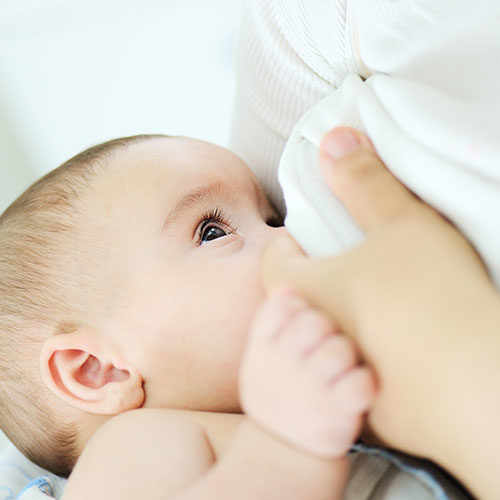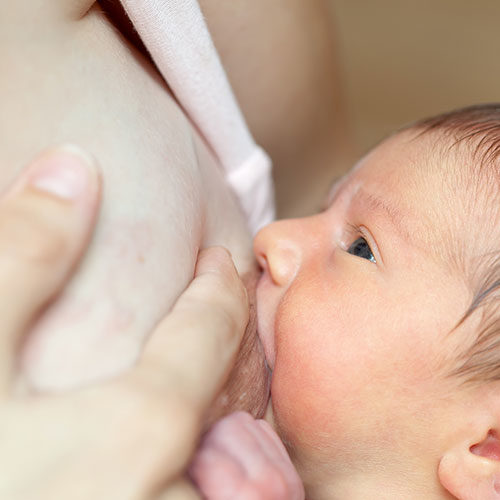Here is a collated list of Frequently asked Breastfeeding Topics.
Alcohol Consumption while Breastfeeding
Breastfeeding women are often given conflicting advice about consuming alcohol. While there is a strong recommendation against consuming alcohol
during pregnancy, there is still a lot of scope for research to be done on the effects of alcohol consumption by the mother on the baby while breastfeeding.
Long-term outcomes, in particular, are unknown.
Alternatives To Bottles
Many mothers use bottles to feed either expressed breast milk (EBM) or artificial breast milk substitute (ABM) to their babies. When a baby is not directly breastfeeding, usually the most often considered option is always a bottle. It is important to know that there are other alternatives available to feed the baby. Read More
Baby Sleep
Sleep in babies is a widely discussed topic as new mothers and parents struggle quite a lot with sleep deprivation. To understand sleep in babies, it is essential to understand the differences in the sleep patterns and sleep cycles between babies and adults.
Read MoreBlind Supplementation of Calcium / Iron / Vitamins to the Baby
A lot of times, infants less than 6 months old are prescribed supplementation as a routine practice, without checking the baby for any deficiency. The most common supplements that are blindly given to babies are calcium, iron, and vitamins. It is important to understand that without a proven deficiency, supplements not only fail to do any good, they actually might do some harm.
Read MoreBreastfeeding and Dental Issues
A lot of women are advised to stop breastfeeding on the pretext of breast milk leading to tooth decay and dental cavities. If we talk about India, the vast majority don't go to dentists for routine checkups. Thus, the interesting thing is that - the women who are advised to stop breastfeeding, are the ones who visit dentists for the poor dental health of their babies. There are plenty of other breastfeeding women who don't take their babies to visit a dentist because their babies do not have any dental issues. This observation, at the least, indicates that breastfeeding is not a sureshot reason to cause dental issues. Because if it was, every baby would need dental treatment.
Read MoreBreastfeeding Positions
The first step at the beginning of every nursing session is positioning.
Positioning essentially describes the body postures of the baby and the mother. Positioning is very important as it helps the baby get a good latch. Typically if the baby is unable to latch properly, both the position and the latch may need to be readjusted. Sometimes, breast also needs to be positioned in order to facilitate nursing. It is important to note that it is not always necessary. And, the need to do it goes on decreasing as the baby grows older.
Read MoreBreastfeeding when the baby is teething/biting
A happily and gently nursing baby suddenly starts chomping down on her mother’s breast. That’s because she is teething!
In most cases, teeth start erupting between 6-12 months of age. This phase can be particularly challenging from the breastfeeding point of view as a lot of times, biting accompanies teething and it can be very painful for the mother. However, it is definitely not the time to wean and there are many ways in which the mother can cope with the situation and continue to breastfeed her baby.
Read MoreBreastfeeding with Abscess
A breast abscess is not very common, but can affect some breastfeeding women. Generally, when a breastfeeding woman faces a blocked duct which is not addressed, it could develop into mastitis. When mastitis is not treated in time, there's a high possibility of infection that contains pus. This is a breast abscess which is very painful.
Read MoreBreastfeeding through Pregnancy
A lot of breastfeeding women are asked to wean their baby when they learn they are pregnant again. In a normal, healthy and low-risk pregnancy, she can continue to nurse her baby throughout the pregnancy and beyond. In cases of high-risk pregnancies (factors involving maternal age and other health conditions, history and risk of miscarriage / early labour, and pregnancy with multiples), it is important to consult the gynaecologist while making a decision about breastfeeding through pregnancy.
Read MoreBreast Preference (Lopsided)
Breast preference is a normal and not so uncommon phenomenon that babies show. Similarly, a mother might notice that one of her breasts is making more milk than the other. This is common too. Just how there are differences in our two hands, legs, eyes; there is quite a plausible difference between the two breasts too. In size as well as in their milk-making/storing capacity and the let-down reflex. This asymmetry is common among humans which can sometimes be barely noticeable, whereas sometimes can be evident.
Read MoreC-Section and Breastfeeding
As many of us have repeatedly heard, the type of birth can potentially affect the breastfeeding relationship and journey of a mother and her baby.
Nowadays, an increasing number of women have started to prefer home births and natural (with no to limited medical interventions) births. However, C-section births are still widespread. Sometimes, they are elective, sometimes they are essential and sometimes they could be misguided or enforced. In any case, the breastfeeding journey that follows post-childbirth needs some special care, attention and in some cases, intervention. Therefore, it's important to educate oneself about them from before.
Read MoreChild - led Weaning
As the name suggests, child - led weaning means that the child’s needs and wishes are followed over anything else while weaning the child. This is also called self-weaning. It means that the child is breastfed until she outgrows the need for it. Another increasingly used term is ‘natural term weaning’; which again implies that the process of weaning does not involve any external interventions and takes place completely naturally.
Read MoreCluster feeding
Cluster feeding, as the name suggests, is a pattern of nursing in clusters. These clusters may be long, intense and frequent. A lot of babies cluster feed in their newborn days. Even though each baby is different and therefore manifests this usual and normal behaviour of cluster feeding in a different and unique way
Read MoreCMPA - Cow's Milk Protein Allergy
Cow’s Milk Protein Allergy or CMPA is also called Cow’s Milk Protein Sensitivity or Cow’s Milk Protein Intolerance depending on its severity. For this article’s purpose, we will call it CMPA.
Read MoreColic
Colic is defined as inexplicable bouts of inconsolable crying in babies less than 3 months old. For a baby to be diagnosed as colicky, her crying outbursts need to last for at least 3 hours, 3 days a week and for 3 weeks at a stretch. In most cases, the diagnosis takes place before the baby has been observed for the above mentioned time frame, making colic an overused diagnosis in case of many babies. Another important thing to remember while making the diagnosis is that the baby should be otherwise healthy and gaining weight.
Read MoreContraception
For women who are not breastfeeding, periods can return as early as 6-8 weeks postpartum. For women who are combi feeding, the return of the period could be a little later. However, for the women who are exclusively breastfeeding their baby, the periods usually return between 9 and 18 months postpartum. Some mothers have even reported the return of their periods as late as 2 yeast and beyond.
Read MoreCovid-19 and Breastfeeding
Covid19 pandemic has impacted our lives in every way possible. The aspect of breastfeeding is not an exception. It is important to understand how breastfeeding can help in this era.
Read MoreDistraction During Breastfeeding
Around the age of 4-5 months, an ever so focussed and dedicated nursling is suddenly pulling away from breast way too often and looks more interested in everything other than the mother’s breast while nursing.
Read MoreEngorgement
One of the common challenges faced by many breastfeeding mothers is engorgement. Engorgement essentially contains the following symptoms.
Read MoreExclusive Expressing / Pumping
Exclusive expressing is the term to refer to providing breast milk for the baby by only expressing and offering. It does not involve direct breastfeeding. When a baby is unable to feed at the breast effectively, some mothers resort to providing breast milk to their baby by expressing.
Read MoreExpressing Milk
Why express breastmilk: There are lots of reasons why you might want to express milk. Your baby can still have the benefits of breastmilk if she’s not able to breastfeed directly due to issues like tongue ties, tight jaws, or if you can’t be with her all the time. For latch, ties, tight muscle jaws it is best to work on resolving the issue with a Lactation Professional before resorting to expressing
Read MoreFalse Alarms of Low Milk Supply
A perceived low milk supply is a major reason for introducing many unnecessary interventions that unfortunately sabotage a breastfeeding relationship. It is commonly observed that new mothers tend to doubt their supply often. It is heartbreaking that women are not encouraged and/or supported enough to trust their own bodies to provide nourishment for their babies. A mother who carries and grows her baby in her womb for 9 months and gives birth to her, can also produce breast milk for her baby and continue to nourish her.
Read MoreFast Letdown/ Overactive Letdown/ Forceful Letdown
Firstly let’s go back to the basics, what is a letdown? Letdown is when the milk starts to flow into the baby’s mouth after the baby has been suckling at the breast. The hormone prolactin tells the milk glands in the mother’s breasts to make more breast milk, and the hormone oxytocin is responsible for getting the breast milk from the mother’s breasts to her baby, which is a letdown.
Read MoreFlat Nipples
Just like breasts, nipples too come in different sizes and shapes. Many times, the same woman may have nipples of more or less different sizes and shapes on each of her breasts.
Read MoreFood & Diet while Breastfeeding
Colic and gas can be so hard to handle, and often times, a mother blames herself or is blamed. The good news is unless the baby is showing symptoms of intolerance (blood in the stool, low weight gain), there's no need to avoid any foods.
Read MoreGalactagogues - Milk Supply Boosters
With all the promotion of supplements to support lactation (also called "galactagogues"), including claims of increase milk production or milk fat, it’s hard not to wonder if perhaps you really do need those products. That’s advertising for the win!
Read MoreGERD
Some babies have a severe reflex which causes them a lot of discomfort and pain. Their spit-ups are usually more frequent and larger in quantity. It may involve occasional projectile vomiting as well.
Read MoreGolden Hour & Colostrum
The first hour after birth is called the golden hour. It is called so because it is very vital in terms of a lot of things. Research has proven that babies are most alert immediately after birth until the first hour is over. From the breastfeeding point of view, it is recommended to start breastfeeding as soon as possible after birth, within the first hour itself. Research has also shown a significant positive correlation between early initiation of breastfeeding and the overall success of breastfeeding.
Read MoreGrowth Spurt
Most babies go through phases when they nurse more frequently than usual and for a longer duration. Sometimes they might nurse for hours together. Babies are also a little fussier during this time. Some people call it ‘frequency days’, some call it ‘wonder weeks’. It is more popularly referred to as - ‘Growth Spurts’.
Read MoreGut Microbiome
Human bodies harbour a vast array of tiny organisms. These micro-organisms include bacteria, viruses, fungi and other microbes. All of these together make the human microbiota. Microbiome refers to all the genes that the microbiota contains.
Read MoreHand to Mouth Milestone
Hand to mouth is the act of a baby bringing her hands to her mouth. This could then turn into the baby sucking on her fingers/thumb or fist. This behaviour can indicate different things depending on the age of the baby.
Read MoreIntroducing Solids
Introducing solids is a big milestone in a baby’s life and even in her breastfeeding journey. Let’s address the different aspects of introducing solids individually viz. When, how, how much, how often, what and what not etc. with relation to breastfeeding.
Read MoreIs my baby getting enough?
The first question every mother has in her mind is -- “Is my baby getting enough?”, followed by the next question -- “Am I making enough for my baby?” To be clear, first, let's understand that these two questions can have different answers. If the baby is not getting enough, it does not imply that the mother is not making enough. There could be problems in the latch and/or milk transfer that may limit the baby's intake. There can be other, more physical problems like a tongue-tie or a lip tie that inhibits baby's ability to latch and therefore get enough. There can be other conditions like reflux, CMPA (cow milk protein allergy), lactose intolerance etc. that may prevent the baby from reflecting his/her intake into sufficient weight gain. Sometimes certain illnesses like jaundice can result in low weight gain. So, a mother could be making more than enough milk and baby may still not be getting enough. Therefore, if the baby is not getting enough, don't be quick to doubt your supply. Always check other factors as well.
Read MoreLactose Intolerance
Lactose Intolerance is the inability to digest lactose (milk sugar). This is not an allergy to milk. Lactose intolerance occurs when the body produces insufficient or no lactase. Lactase is an enzyme that is secreted in our small intestines to break down lactose.
Read MoreLatch
In order to get milk from the breast, the baby must latch onto the breast. The word "latch" describes the way a baby takes the breast into his/her mouth. The better the latch, the more easily the baby gets mother's milk. The following "deep latch technique" can help your baby feed more easily. It can also prevent damaged and sore nipples.
Read MoreMastitis
Mastitis is a condition wherein the breast is inflamed with or without infection. It is more often than not the result of a plugged/clogged duct that is not cleared out. The build-up of milk that occurs in the duct due to obstruction of the duct causes the area to swell up and get inflamed. When it is not addressed in due time, the inflammation worsens and turns into mastitis.
Read MoreMilk Production in the body
Pregnancy changes hormones in a woman’s body and kicks start the process of milk production somewhere in the second trimester. When the baby is delivered, the mother’s body already has the milk (colostrum) for the baby. This milk is released due to the hormonal shift brought about by the delivery of the baby and placenta. Usually, the mature milk comes in within 2-3 days post-delivery.
Read MoreNICU Baby
Babies are admitted in NICU for a variety of reasons. In most cases, there is a separation of the mother and the baby. In some cases, the mother might be able to visit the baby. And in some fortunate cases, the mother might be able to stay at the facility and can stay available to breastfeed the baby at all hours.
Read MoreMaternal Diabetes and Breastfeeding
This type of diabetes is believed to be a result of the body's auto-immune response. The immune system attacks the pancreas and destroys the cells that produce insulin.This type of diabetes starts as insulin resistance which means that the body cannot use the insulin efficiently. The body produces more and more insulin to keep the blood sugar levels normal until it can no longer cope up with the need for it. It gradually results in high blood sugar.
Read MoreMaternal HIV and Breastfeeding
The transmission of HIV from the mother to the child can occur during pregnancy, childbirth and breastfeeding. The risk of transmission during pregnancy is about 7%. The risk during childbirth is up to 15%. And the risk during breastfeeding is also up to 15%.
Read MoreMenstrual Periods while Breastfeeding
The time when the periods return after the birth of the baby varies from woman to woman. A major factor affecting it is whether or not the woman is breastfeeding, and how much.
Read MoreMilk Bleb/Blister
A milk blister or a milk bleb is a tiny dot on the nipple causing nil to severe pain. It can be of three types. A milk blister can be caused by a blocked or plugged duct wherein the blockage occurs almost just at the nipple. Here, the obstruction is due to a tiny clump of hardened milk or a string of fattier milk which has difficulty flowing out. Thus, it looks like a white/yellowish dot on the nipple.
Read MoreNursing in Public/Breastfeeding in Public
As we famously call it NIP (Nursing In Public) at BSIM, it is a very important part of any breastfeeding journey. NIP is not just convenient, but also incredibly empowering. Nursing in public is a right of a breastfeeding mother and her baby alike. Just how the grown-ups can eat in public places, a baby has the right to eat her food too.
Read MoreNipple Shields
A nipple shield is a flexible silicone nipple which is placed over the mother’s nipple. It sometimes covers the areola and sometimes some part of the areola.
Read MoreNursing Lying Down
Often, mothers are told not to nurse in the lying down position by well-meaning but ill-informed family members and/ or medical professionals.
Read MoreNursing Multiples
As the name suggests, breastfeeding multiples involves nursing more than one baby in the same time span. It does not necessarily mean that two or more babies should be nursed simultaneously at the same moment. What it means is that the mother’s body is making milk for two or more babies and she is nursing them both in a specific given time frame.
Read MoreNursing Premature Baby
Preterm is defined as babies born alive before 37 weeks of pregnancy are completed. Breastfeeding a baby who is born preterm can be challenging and difficult, but is attainable. We will focus on two parts of it.
Read MoreNursing Sleepy Baby
Until the baby regains birth weight, it is important to nurse the baby every 1.5 to 2 hours or on-demand; whichever is earlier. Sometimes, some babies sleep for longer durations. Such naps could go beyond 2 hours. At the newborn stage, it is important to wake the baby up for nursing.
Read MoreNursing Strikes
When babies reject direct breastfeeding consistently, even if they're really hungry and it's been hours from their previous feed. This is termed as a nursing strike. Nursing strikes are worrisome. During nursing strikes and teething is not a great time to introduce new ideas and ask the baby to stretch their skill-set. Using consistent, usually effective relaxed strategies to offer milk to baby usually gets them through the challenge. Offering to nurse while the baby is sleeping is sometimes effective as it calls on their inborn feeding reflexes.
Read MoreNursing or Breastfeeding Aversion and Agitation (BAA)
Nursing aversion or Breastfeeding aversion and agitation is a phenomenon that some women experience in their breastfeeding journey. It is an experience marked with negative feelings and intrusive thoughts while the baby is latched on and is breastfeeding.
Read MoreNursing through Common Maternal Illness
There are very few illnesses that might warrant a need for a mother to stop breastfeeding her baby. For most common as well as uncommon maternal illnesses, it is recommended to continue nursing through them. Ordinary and common illnesses like the common cold, cough, flu, stomach upset, fever, sore throat, mastitis do not require a mother to stop breastfeeding. In fact, breastfeeding through the illness will prove beneficial for the baby.
Read MoreOversupply
Just as low supply is a problem, oversupply too is a problem lying on the other end of the continuum. Usually, the milk supply gets established and adjusted as per the baby's needs in the first 6 weeks. This is a crucial time to ensure that the baby's actual needs are communicated to the mother's body and a balance between demand and supply is stricken. If the baby doesn't nurse optimally at the breast, the supply takes a hit. Similarly, if breast milk requirement is communicated to the mother's body in access, the supply increases more than the baby's actual needs - resulting in oversupply.
Read MorePaced Bottle Feeding
Plugged/Clogged Ducts
A breastfeeding woman may notice it as a small hard lump which feels tender, little swollen, sometimes red and slightly hot. When a milk duct is obstructed, it can happen at the pore in the form of a milk blister, or deep inside the ductal system where one can’t really see it, but can only be felt.
Read MorePolycystic ovary syndrome (PCOS)
Polycystic Ovarian Syndrome, more commonly referred to as PCOS is a complex condition caused by an imbalance in reproductive hormones. It affects 5% to 10% of women of reproductive age.
Read MorePoop! (Colour, Texture, and More)
The Baby’s first stool should be passed within 24 hours after birth. On the first couple of days, the stool is black. This is called meconium. It's the black substance collected in a baby's intestines during pregnancy. The more efficient the breastfeeding, the faster the meconium transforms into green and then mustard yellow stools. The frequency of stool, like that of urine, increases every day. Once on day 1, twice on day 2, and so on. By day 5, the mature milk has come in, and the stools must become mustard yellow in color.
Read MorePostpartum Depression & Anxiety
A woman undergoes many changes during pregnancy and after the birth of the child. These changes are physical, mental and emotional and psychological in nature. There are also many social changes in the woman’s environment that come into play after giving birth to her baby. Additionally, the internal hormonal changes impact and drive the mother’s response to these changes as well.
Read MorePostpartum Hair Fall
Most women notice a more than usual hair fall at around 3 months after giving birth to their baby. Many women attribute it to breastfeeding but that’s a myth. The real cause of postpartum hair fall lies in hormonal changes during pregnancy. It happens to most mothers irrespective of whether or not they are breastfeeding. It is also normal and it is temporary.
Read MoreReflux
The very common phenomenon of babies spitting up some milk right after or in between feeds is called ‘Reflux’. Many infants spit up milk. It can be curdled sometimes. This is observed commonly and the reason is that - the digestive system of the babies are still not mature and therefore the milk, even after entering the stomach, can flow back up into the oesophagus (more commonly referred to as the food-pipe, connecting mouth and stomach) and from there into the mouth of the baby, causing the spit-ups. In most cases, these spit-ups are in small quantities and do not cause any discomfort to the baby.
Read MoreRisks of Not Breastfeeding
Breastfeeding is a biological norm. All mammals are biologically designed to nourish their young through breastfeeding. It is only normal. When there is a deviation from the normal, there may be consequences. These consequences occur due to suboptimal or no breastfeeding.
Read MoreSelf Care
A mother’s mental and physical well being is equally important to ensure the baby’s well being. It is also elementary in achieving one’s breastfeeding goals.
Read MoreSetting boundaries while breastfeeding
Breastfeeding is a relationship between the mother and her baby. There are two parties involved and both are important.
WHO recommends that a baby should be breastfed for a minimum of 2 years and beyond. As the baby grows older than that, some mothers may find it difficult to continue to nurse the child due to various reasons listed below and many more.
Sleep Regression
As the name suggests, regression means a demotion or return to an earlier state. Sleep regressions are when a baby who has started sleeping in a set routine suddenly starts waking up very often. Babies find it difficult to fall and stay asleep during sleep regressions.
Skin to Skin
Frequent and/or prolonged skin to skin contact between an infant and caregiver (mostly mother, and even father) is a very effective technique to
- Facilitate bonding
- Improving milk supply
- Getting baby back to breast
- Soothe an inconsolable baby
- Maintain baby’s temperature, blood pressure, blood sugar level, oxygen level, breathing and heart rate
- Reduce maternal stress and PPD occurring due to separation
- Help boost the baby’s immune system
Sore Cracked Nipples
Breastfeeding, for a first time new mother, may take a little while to get used to. For some women, breastfeeding causes a little discomfort in the beginning. In most cases, this is just a physical response toward trying something new. It settles in a couple of days. For some women, the initial process of latching the baby on could be mildly painful. This pain is mild, transient and disappears within a few seconds. The rest of the nursing session is painless. In the above-described scenarios, mild discomfort and mild pain do not need any treatment. It settles on its own within a few days.
Read MoreSpit - Ups
Firstly assess if the baby is Spitting up milk or if it is a Projectile vomiting. In case of a projectile vomiting, it is best to see your paediatrician as soon as possible.
Read MoreThyroid & Breastfeeding
Thyroid Gland plays an important part in lactation as it is connected with the regulation of prolactin (the hormone responsible for milk production) and oxytocin (the hormone responsible for ejecting the milk flow).
Read MoreWeaning Breastfeeding
WHO recommends that a baby should be exclusively breastfed for the first 6 months of life. And breastfeeding should continue for a minimum of 2 years and beyond. There is no upper age limit suggested at which breastfeeding should be stopped. Breastfeeding is a relationship between a mother and her baby. And they should be encouraged and supported to continue this relationship for as long as they wish to.
Read MoreWeaning off Formula (Bringing Baby back to Breasts)
Bar some uncommon and rare conditions wherein it is genuinely required; formula is often advised by medical professionals and/or well-meaning family members and friends under the pretext of following reasons.
Read MoreWeightloss & Fitness While Breastfeeding
Post the birth of the baby, a lot of women start thinking about losing the weight gained during pregnancy. This happens, for some, due to the familial/societal pressure and/or conditioning and for some other, due to their own wishes and expectations. Losing the pregnancy weight can be a lengthy process for the simple logic that - the woman carried her baby in her womb for 9 months and she took 9 months to gain that weight. Losing it could take just as long or perhaps a little longer.
Read MoreWeight gain in Breastfed Babies
When we talk about full-term healthy babies, nearly all of them lose weight post-birth. Any loss of weight between the range of 5% to 7% is considered normal. Some babies might lose up to 10% of their birth weight. Once the weight loss crosses the 10% mark, it is a concern and should be brought to the notice of a paediatrician. A weight loss of more than 15% is alarming and needs immediate medical attention.
Read MoreWhat is hand expression and how can I go about it?
Hand expression is a way of removing milk from a mother’s breast without needing any devices like a manual or electric pump. It is an acquired skill and one gets better with consistent practice.
Read More





